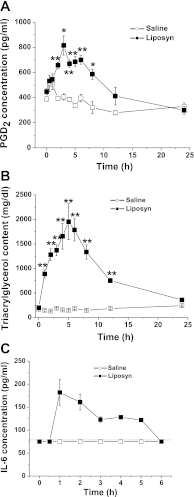Activation of rat intestinal mucosal mast cells by fat absorption
- PMID: 22461027
- PMCID: PMC3378165
- DOI: 10.1152/ajpgi.00011.2012
Activation of rat intestinal mucosal mast cells by fat absorption
Abstract
Previous studies have linked certain types of gut mucosal immune cells with fat intake. We determined whether fat absorption activates intestinal mucosal mast cells (MMC), a key component of the gut mucosal immune system. Conscious intestinal lymph fistula rats were used. The mesenteric lymph ducts were cannulated, and the intraduodenal (i.d.) tubes were installed for the infusion of Liposyn II 20% (an intralipid emulsion). Lymphatic concentrations of histamine, rat MMC protease II (RMCPII), a specific marker of rat intestinal MMC degranulation, and prostaglandin D(2) (PGD(2)) were measured by ELISA. Intestinal MMC degranulation was visualized by immunofluorescent microscopy of jejunum sections taken at 1 h after Liposyn II gavage. Intraduodenal bolus infusion of Liposyn II 20% (4.4 kcal/3 ml) induced approximately a onefold increase in lymphatic histamine and PGD(2), ∼20-fold increase in lymphatic RMCPII, but only onefold increase in peripheral serum RMCPII concentrations. Release of RMCPII into lymph increased dose dependently with the amount of lipid fed. In addition, i.d. infusion of long-chain triacylglycerol trilinolein (C18:2 n-6, the major composite in Liposyn II) significantly increased the lymphatic RMCPII concentration, whereas medium-chain triacylglycerol tricaprylin (C8:0) did not alter lymph RMCPII secretion. Immunohistochemistry image revealed the degranulation of MMC into lamina propria after lipid feeding. These novel findings indicate that intestinal MMC are activated and degranulate to release MMC mediators to the circulation during fat absorption. This action of fatty acid is dose and chain length dependent.
Figures







References
-
- Bischoff SC. Physiological and pathophysiological functions of intestinal mast cells. Semin Immunopathol 31: 185–205, 2009 - PubMed
-
- Calder PC. Polyunsaturated fatty acids, inflammatory processes and inflammatory bowel diseases. Mol Nutr Food Res 52: 885–897, 2008 - PubMed
-
- D'Alessio D, Lu WD, Sun W, Zheng SQ, Yang Q, Seeley R, Woods SC, Tso P. Fasting and postprandial concentrations of GLP-1 in intestinal lymph and portal plasma: evidence for selective release of GLP-1 in the lymph system. Am J Physiol Regul Integr Comp Physiol 293: R2163–R2169, 2007 - PubMed
Publication types
MeSH terms
Substances
Grants and funding
LinkOut - more resources
Full Text Sources
Miscellaneous

